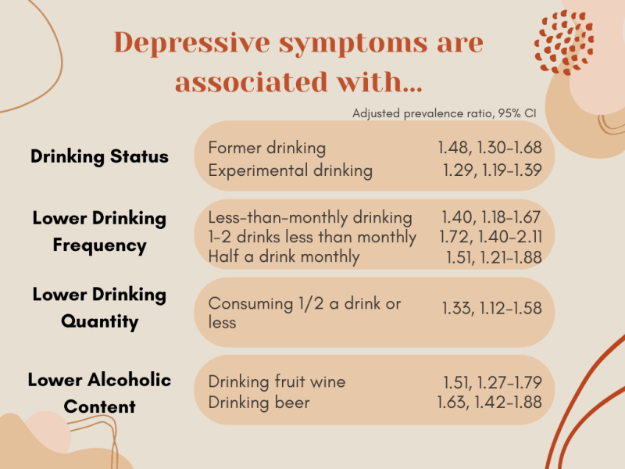Underage drinking and depression are concerns worldwide. Starting to drink early in life is associated with alcohol abuse and chronic health conditions. In the US, a 2019 survey revealed that 19% of adolescents reported drinking alcohol. Moderate and heavy drinking are linked with depression. However, there is insufficient research on light alcohol consumption and its relationship with depression. This week, The DRAM reviews a study by Xiaoyu Zhang and colleagues that examined the association of light drinking in Hong Kong adolescents with depressive symptoms.
What was the research question?
Is there an association between light drinking and depressive symptoms in adolescents?
What did the researchers do?
A total of 20,951 students from 44 randomly selected secondary schools in Hong Kong completed questionnaires. The survey included general demographic items and questions about lifestyle choices (e.g., smoking) and drinking behavior (e.g., frequency and quantity of alcohol consumed). The survey also included questions from the Patient Health Questionnaire that are used to assess depression. The researchers used analysis of variance and chi-square tests to assess the relationship between the demographics and lifestyle characteristics and the depressive symptoms. They also used Poisson regression to adjust for other factors.
What did they find?
Light drinking was still associated with depressive symptoms in adolescents when compared to lifetime abstainers (see Figure). Depressive symptoms were associated with consuming alcoholic beverages of low alcoholic content and consuming no more than half a drink. Depressive symptoms were also associated with both experimental drinking (having consumed alcohol only a few times) and former drinking. These associations were found to be even stronger in younger participants.
Figure. Depressive symptom associations using adjusted prevalence ratio and 95% confidence interval (ex. 1.48 adjusted prevalence ratio, 1.30-1.68 95% confidence interval). All comparisons are against lifetime abstainers. Click image to enlarge.
Why do these findings matter?
For adolescents, even light drinking can be associated with mental health conditions, both in the present and the future. While adolescents may perceive lower alcoholic content drinks or infrequent drinking as less dangerous, it is still harmful compared to not drinking at all. Additionally, parents may have thought that introducing small amounts of low-alcohol drinks could be harmless or even helpful, but these findings suggest otherwise. Public health efforts should also include light drinking as a topic of concern, rather than focusing only on moderate or binge drinking. This may include promoting complete abstinence from alcohol among adolescents.
Every study has limitations. What are the limitations of this study?
Due to the cross-sectional nature of this study, the researchers could not specify the extent to which drinking led to depression or vice versa. While this study does have statistical controls, it does not account for family dynamics and other factors that may increase risks for both drinking and depression. Additionally, although the surveys were anonymous, the students still completed them in classrooms. This may have introduced social desirability bias and students may have misreported their alcohol consumption or behaviors.
For more information:
Parents, guardians, and other adults who want to have conversations with youth about alcohol, tobacco, and substance use can find information at TalkSooner. They provide drug facts, age-specific talking tips, and a glossary of drug-related terms.
The National Institute on Alcohol Abuse and Alcoholism also has tips and resources for people struggling with problem drinking. For additional drinking self-help tools, please visit our Addiction Resources page.
— Taylor Lee
What do you think? Please use the comment link below to provide feedback on this article.





